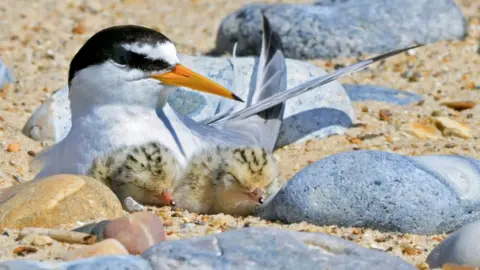Fencing to protect ground-nesting birds at beach
 RSPB/PA
RSPB/PAA beach is to have fencing installed to protect ground-nesting birds and boost their numbers at a key breeding site.
The RSPB said it wanted to reduce disturbance from people and dogs for little terns, ringed plovers and oystercatchers at Kessingland near Lowestoft, Suffolk.
The stretch of sand, and south to Easton Broad near Southwold, is the most important breeding area in the county for little terns "by a very large margin".
"By creating these protected areas, we hope to increase the numbers of pairs and chicks successfully fledging," said Pamela Hallesy of the RSPB beach nesting project.
The fencing is expected to go up later this month.
The little tern's vulnerable nesting sites and the decline in Europe made it an important species to protect on the Suffolk coast, the RSPB said.
Breeding numbers were also in decline across the UK for ringed plover and oystercatcher, with both species "demonstrably impacted by high disturbance".
Two fenced-off areas would be in situ until the last chick fledges in the summer, with the vast majority of Kessingland beach still available to the public, the RSPB added.
Wildlife Wise, a partnership of four Suffolk councils which works closely with nature organisations, gave the RSPB £4,900 towards the project and said its rangers would play an active role in monitoring the site.
"We want to ensure that people enjoy the beaches and share them with wildlife, allowing nature to thrive," said delivery manager Sam Kench.
Follow Suffolk news on BBC Sounds, Facebook, Instagram and X.
